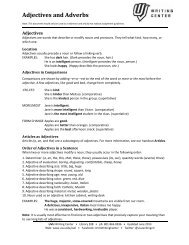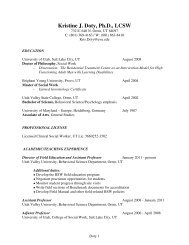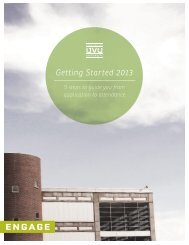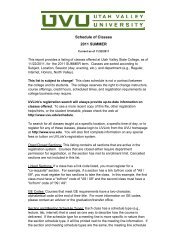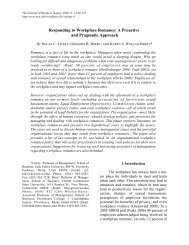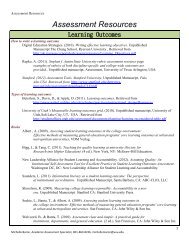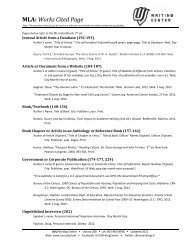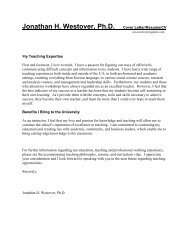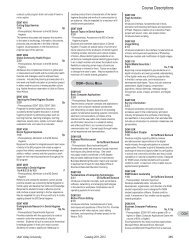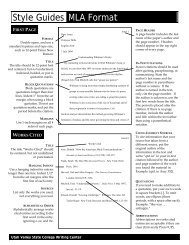Using Case Studies to Develop Critical Thinking Skills in ... - uvu.edu
Using Case Studies to Develop Critical Thinking Skills in ... - uvu.edu
Using Case Studies to Develop Critical Thinking Skills in ... - uvu.edu
- No tags were found...
You also want an ePaper? Increase the reach of your titles
YUMPU automatically turns print PDFs into web optimized ePapers that Google loves.
24 Teach<strong>in</strong>g Ethics, Fall 2002(which would otherwise be simply destroyed) part of Adam Nash, or par<strong>to</strong>f his mother, or both? At the very least, it is ambiguous whether Adamis the one be<strong>in</strong>g used <strong>in</strong> this case (if usage occurs at all). It would seem <strong>to</strong>be a different case if one were <strong>to</strong> conceive a child that is free of disease,then after rais<strong>in</strong>g the child demand a transplant, say, of one of his kidneys,s<strong>in</strong>ce this is a match for an ail<strong>in</strong>g sibl<strong>in</strong>g. That would seem <strong>to</strong> usethe child, and <strong>to</strong> do so <strong>in</strong> an unacceptable way without regard <strong>to</strong> the possibleharm <strong>to</strong> the child.The question of harm <strong>to</strong> Adam Nash also seems <strong>to</strong> be important,and this suggests another way <strong>to</strong> <strong>in</strong>terpret the categorical imperativewhich <strong>in</strong> some way <strong>in</strong>volves the effect that one’s acts have on the personwho is putatively used merely as a means. This <strong>in</strong>terpretation may beunacceptable <strong>to</strong> some followers of Kant s<strong>in</strong>ce it seems <strong>to</strong>o “Utilitarian,”but it does raise an <strong>in</strong>terest<strong>in</strong>g issue. In the typical example of a ly<strong>in</strong>gpromise, another person is used merely as a means and this is a case <strong>in</strong>which the person used is clearly harmed. What if a person is used merelyas a means, but <strong>in</strong> cases such as Adam Nash’s, no harm results directlyfrom this s<strong>in</strong>ce us<strong>in</strong>g the cord blood has no negative effects on him atall? Even if we could get clear on the fact that it is he who is used, (andused merely as a means) if there is no harm, does the Kantian pr<strong>in</strong>ciplestill <strong>in</strong>tuitively ground the moral wrongness of such actions? If not, perhapsthe Kantian stricture aga<strong>in</strong>st us<strong>in</strong>g persons as a mere means r<strong>edu</strong>ces<strong>to</strong> the harm result<strong>in</strong>g from be<strong>in</strong>g used <strong>in</strong> this way. This l<strong>in</strong>e of question<strong>in</strong>gsheds critical light on whether Kant’s pr<strong>in</strong>ciple is a foundational moralpr<strong>in</strong>ciple.This discussion illustrates a way <strong>in</strong> which case studies can be used <strong>to</strong>test ethical pr<strong>in</strong>ciples themselves. I am not claim<strong>in</strong>g that this is the onlyway or the best way <strong>to</strong> critically analyze ethical pr<strong>in</strong>ciples. I see thismethod as complex, us<strong>in</strong>g a number of different strategies, <strong>in</strong>clud<strong>in</strong>g thisapproach as well as (e.g.) argument by counterexample, appeal <strong>to</strong> <strong>in</strong>tuitions,et cetera. The power of cases <strong>to</strong> critically assess ethical pr<strong>in</strong>ciples,which is one task of an ethics course, should not be underestimated.THE CASE OF “JODIE” AND “MARY”The other case I will discuss is that of two conjo<strong>in</strong>ed tw<strong>in</strong>s born <strong>in</strong>2000 named “Jodie” and “Mary.” Jodie and Mary were jo<strong>in</strong>ed at theirlower abdomens, and Mary’s bra<strong>in</strong> and body were less developed thanJodie’s. Mary exhibited very little activity, and experts reported that herbra<strong>in</strong> was “extremely primitive” and found that she had no realistic



